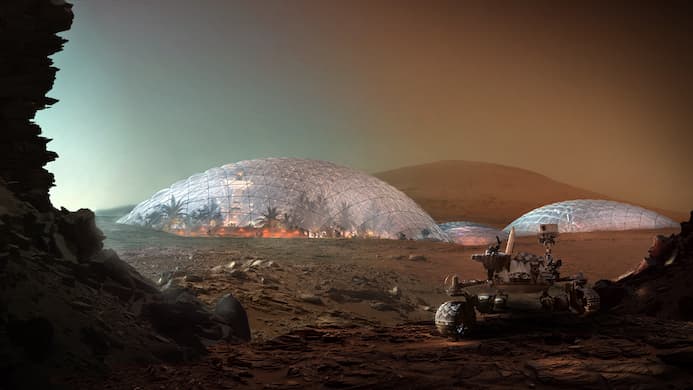Thinking of Moving Your Lab to a Place With More, ah, Space?
When humans are able to walk spacesuit-less as true Martians, what will their habitats and environments look like?

So, you’re thinking of moving — to, say, another planet? Then you might want to know about the emerging field of Space Architecture for places like, say, Mars. Would you like an indoor garden, maybe one that’s connected to outdoor walking paths?
James Green, former director of the planetary science division at NASA, stated last month in an interview with the New York Times that he and his colleagues have been researching technology that would alter a planet’s atmosphere to create conditions more conducive to human inhabitation. Mars was the first planet in question.
The Red Planet, a favorite setting of science fiction lore, is plagued with extremely cold temperatures, harsh winds, and a “thin” — low pressure — atmosphere. Dr. Green’s research focuses on placing a device between the planet and the sun that would increase surface temperatures and air pressure on planets like Mars and another potential home-building site, Venus.
When humans are able to walk spacesuit-less as true Martians, what will their habitats and environments look like? Innovative professionals leading the field of Space Architecture have been developing prototypes, drawings, and models to answer this question for more than a decade, awaiting advances in aerospace technology and funding to propel their projects into orbit.
NASA and the European Space Agency have been working with architecture firms and innovators around the world, holding competitions for prototype development. A Danish “starchitect” firm, the Bjarke Ingels Group, or BIG, and NASA are 3D printing a 1,700-square-foot test structure. Named Mars Dune Alpha, it’s to be completed and used in a Texas-grounded simulation, according to iconbuild.com.
Without the benefit of full-sized construction teams on early planetary sites, most current Space Architecture projects are intended for robotic production. The BIG team partnered with 3-D printing company ICON for the Mars Alpha project, and aims to start its Mars habitation experiment as soon as this coming fall.
Since 2017, BIG has also worked with the government of the United Arab Emirates to develop an idea for a more comprehensive system of human habitable domes on Mars, titled Mars Science City. Before Dr. Green’s prediction of planetary solar shields, this type of fully protective-skin system on the surface was more of an assumed prerequisite to building in space. In order to negotiate between these advances in science and space architecture, professionals have formed several leadership bodies.
The Space Architecture Technical Committee is a body of architects, aerospace engineers, and other professionals focused on progress in the field of Space Architecture. Barbara Imhof, Walter Hoheneder, and a team at LIQUIFER Systems Group are leaders in the industry.
In a lecture at the Southern California Institute of Architecture, Dr. Imhof explained that their research into space-related habitats and technologies is meant to have potential terrestrial applications for Earth, as well. Even as we explore the next frontier, prototypes like Dr. Imhof’s Self Deployable Habitat for Extreme Environments and exploration of new materials have tangible potential for a variety of uses.
Until now, many Space Architecture designs assumed that the building structures would need to factor in the extreme pressure differential between a planet’s atmosphere and what would have been experienced by Earth-accustomed residents. Many designs also include indoor gardens and areas for onboard water and food production (think the garden car in the Snowpiercer series).
Yet with Dr. Green’s new research and the potential of viable outdoor climatic conditions, would it be possible to grow food outside? Store water in tanks? Have outdoor walking paths?
If we are able to terraform — meaning change the environment of — a moon or planet, the logical next step is habitation. Habitats would most likely include laboratories for astronomical and planetary experimentation, sleeping spaces, and general living spaces.
Although these first trial phases of community building may be dedicated to creating a strong base for professional scientists and engineers, it is easy to imagine that the hospitality industry would soon follow.
As billionaire entrepreneurs Jeff Bezos and Elon Musk pioneer the space-tourism industry, one might expect the hospitality industry to take part in future stages of development. It would give new meaning to a room with a view.

